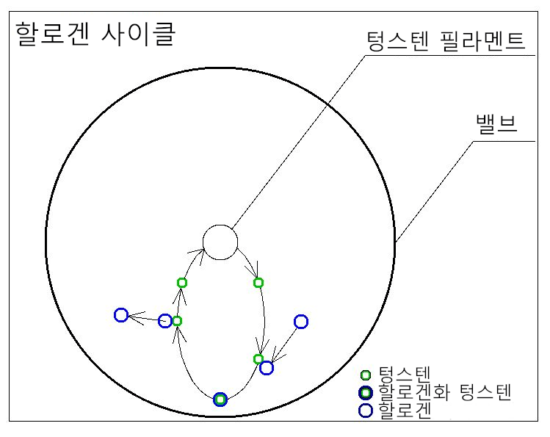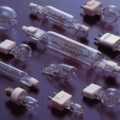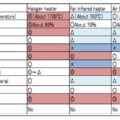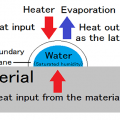할로겐 램프 가스 종류
할로겐 램프는 램프 내에 불활성 가스와 미량의 할로겐 가스를 봉입한 백열 전구입니다.
불활성 가스
불활성 가스에는 헬륨(He 4.00g/mol), 네온(Ne 20.18g/mol), (질소(N2 28.02/mol)), 아르곤(Ar 39.95g/mol), (이산화탄소(CO2 44.01g/ mol)), 크립톤(Kr 83.80/mol), 크세논(Xe 131.29g/mol), 라돈(Rn 222.000/mol)이 있습니다.
헬륨·네온·아르곤·크립톤·크세논·라돈은 공기 중에 미량 밖에 포함되어 있지 않기 때문에, 귀가스나 레어 가스라고도 알려져 있습니다.
필라멘트에 사용되는 텅스텐의 증발 억제 효과는 원자량이 큰 것만큼 효과가 있습니다. 원자량이 클수록 열전도율이 낮아 필라멘트의 열손실을 억제할 수 있습니다. 발광 효율로 5~10%씩 상승합니다.
“이론상 가장 원자량이 많은 라돈이 효과가 높습니다. 그러나, 라돈은 단반감기의 알파선을 방출하는 유해한 방사성 가스이므로 사용할 수 없습니다. 이산화탄소도 1000℃ 이상이 되면 일산화탄소와 산소에 열분해되기 때문에 사용할 수 없습니다.
그 때문에, 크세논이 텅스텐의 증발에 가장 효과적이라고 말할 수 있습니다.
그러나 크세논과 크립톤은 가격이 비싸기 때문에 별로 사용되지 않고 불활성 가스 중에서는 가격이 저렴한 아르곤이 사용되고 있습니다. ”
그러나, 아르곤만으로는 전기 절연성이 불충분하기 때문에, 필라멘트가 점등시에 단선하면 아크 방전이 일어납니다. 그 대책으로서 전기 절연성이 높은 질소를 미량으로 혼합하고 있습니다. . 소형화된 램프로 필라멘트가 짧으면 전기 부하가 많아지므로 수명은 짧아지지만 전기 절연성이 높은 질소만을 사용하는 경우도 있습니다.
게터
진공을 사용하는 제품으로 불순물을 제거하는 데 사용되는 화학 재료를 게터라고 부릅니다.
백열구에서는 밸브내에 미량의 수분이나 산소 등의 불순물이 혼입되어 있으면, 워터 사이클을 일으켜, 텅스텐을 소모시켜 단수명의 원인이 되므로, 밸브내의 물을 제거할 필요가 있습니다. 대책으로서 다양한 게터가 연구 개발되고 있습니다. 백열 전구에서는 제조 과정에서 인 게터를 사용하여 진공으로 하는 방법이 채용되고 있습니다. 텅스텐 필라멘트를 인과 물의 혼합액에 담그고 램프 배기 후에 통전하여 글로우 방전을 발생시켜 잔류 가스를 제거하는 방법입니다. 인 게터는 진공도를 높이기 위해 사용되고 있습니다만, 그 외에 흑화 현상을 방지하는 게터로서 봉입된 것이 할로겐 원소입니다.
할로겐 원소를 게터로 이용하여 흑화를 줄이는 방법은 옛날부터 채용되고 있으며, 1892년에는 염소를 넣은 카본 필라멘트 전구가 발매되었습니다. 1933년에는 요오드를 봉입하고 증발한 텅스텐을 요오드화 텅스텐으로 하여 밸브에 부착하는 것을 방지하는 아이디어가 특허 제안되었습니다. 이와 같이 종래의 전구에 할로겐 화합물을 봉입하는 방법은 밸브의 흑화를 막는 효과는 있었지만, 저온 부분의 텅스텐 필라멘트와 반응하여 단수명이 되는 문제가 발생하여 실용화는 그다지 진행되지 않는다. 했다. 또, 요오드는 제조시에 기화하여 밸브 내에 넣는 작업이 필요하고, 할로겐 사이클이 안정 작용하는 범위가 좁은 등의 단점이 있었기 때문에 다른 할로겐 가스가 검토됩니다. 1965년에 필립스의 야펜스(T’. Jampens)와 웨이어(van der Weijer)에 의해 브롬의 유기 화합물을 사용하는 전구가 발표되었습니다. 브롬 화합물(CHBr3, CH2Br2 등)은 증기압이 높기 때문에 그대로 기체로서 봉입할 수 있고, 활성이 높기 때문에 할로겐 전구의 종류를 넓힐 수 있게 되었습니다. 그런 다음 염소 화합물도 사용되며 복사기 노출을위한 램프에 사용됩니다.
또, 게터로서 일반 전구에 많이 사용되고 있는 것은 지르코니아입니다. 그러나 할로겐 램프 히터와 같은 경우는 이것은 사용하기 어려우므로, 탄탈(Ta)이 사용되는 것이 많습니다. 탄탈은 납을 닮은 부드러운 고융점 금속으로, 암 적열 상태(약 700℃)로 그 체적의 수백배의 수소를 흡수하기 때문에, 필라멘트의 지지 부품에 이 금속을 사용해 게터의 작용을 시켜 있습니다.
물론 2200K 이하의 램프 히터에서도 할로겐을 넣고있는 것도 있습니다. 할로겐을 넣으면 워터 사이클을 저해하는 방향으로 작용하기 때문에 잔류 수분이 적으면 장수명의 히터도 만들 수 있습니다. 이것은 할로겐을 넣는 것이 비용이 낮다는 이유가 많습니다. 수명이 5000시간~20000시간의 설계로 고신뢰성의 램프 히터를 만들려면 할로겐을 넣는 것보다 할로겐 없이 게터를 넣는 것이 안전하다.
할로겐 가스
할로겐 가스에는 불소(F 19.00g/mol), 염소(CL 35.45/mol), 브롬(Br 79.90g/mol), 요오드(I 126.90g/mol)의 4종류가 있습니다. 원자량이 작을수록 반응 성이 높아지기 때문에 요오드가 가장 온화한 반응성입니다.할로겐 램프의 초기에는 할로겐 물질로서 요오드가 봉입되어있었습니다. 그러나, 요오드는 제조시에 기화하여 밸브 내에 넣는 작업이 필요하고, 또 할로겐 사이클이 안정 작용하는 범위가 좁은 등의 단점이 있었기 때문에, 다른 할로겐 가스가 검토되고 브롬이 현재는 주 에 사용됩니다”
“브롬은 요오드보다 반응성이 높고 할로겐 사이클의 효과에 기여합니다.
요오드의 할로겐 사이클로 대응할 수 없어 텅스텐의 증발·흑화 현상을 일으키고 있던 경우에서도 할로겐 사이클을 대응할 수 있게 되어, 할로겐 램프의 종류를 넓힐 수 있게 되었습니다. ”
또한 할로겐 사이클에서 궁극적으로 텅스텐이 필라멘트로 돌아가는 곳에 변동이 있습니다. 국부적으로 증발이 촉진되어, 그 부분의 온도가 가속적으로 높아져, 이른바 핫스팟의 개소에서 단선합니다.
또한 할로겐 가스의 양에 따라 흑화 현상이 일어날 수 있습니다. 흑화 현상을 일으키지 않는 최소한의 할로겐 가스를 봉입할 필요가 있습니다. 할로겐 가스의 양을 최소화함으로써 할로겐 사이클을 부드럽게 함으로써 램프의 수명이 길고 안정화됩니다. 최소한 필요한 농도는 불활성 가스에 관하서 몰비로 약 0.1%이다.
또한 할로겐 가스의 양에 따라 흑화 현상이 일어날 수 있습니다. 흑화 현상을 일으키지 않는 최소한의 할로겐 가스를 봉입할 필요가 있습니다. 할로겐 가스의 양을 최소화함으로써 할로겐 사이클을 부드럽게 함으로써 램프의 수명이 길고 안정화됩니다. 최소한 필요한 농도는 불활성 가스에 관하서 몰비로 약 0.1%이다.
색온도가 2200K(K→켈빈:절대온도의 단위.℃에 플러스 273한 값) 정도 또는 그 이하의 램프히터는 할로겐을 넣을 필요는 없습니다. 이러한 색온도에서는 히터의 설정 수명 내(5000시간이나 20000시간)에서의 텅스텐의 증발은 적고, 할로겐 사이클은 불필요합니다. (따라서 필라멘트는 거의 소모되지 않는다 → 수명은 이것에 의해 제한되는 것은 아니다)
할로겐 사이클
할로겐 램프는 램프 내에 아르곤이나 질소와 같은 불활성 가스에 미량의 할로겐 가스를 봉입한 백열 전구의 일종입니다.
할로겐 가스를 봉입함으로써, 필라멘트의 재질인 텅스텐의 손모를 방지하고, 필라멘트를 보다 고온으로 하는 것이 가능하고, 램프의 흑화 감소가 일어나지 않고, 나아가 빛의 밝기가 저하되지 않는 등 장점이 있습니다. 이것은 할로겐 사이클 때문입니다. 램프 점등 중에 고온이 된 텅스텐의 필라멘트는 증발하여 원자상이 되어 램프 내를 이동합니다. 이동할 때 램프 안의 할로겐과 결합하여 할로겐화 텅스텐을 형성합니다. 할로겐화 텅스텐은 대류와 확산에 의해 필라멘트 부근으로 이동합니다. 점등 중에 고온이 된 필라멘트에 의해 할로겐화 텅스텐이 1400℃ 이상이 되면 분리되어 텅스텐은 필라멘트로 돌아가, 할로겐은 다시 증발한 텅스텐과 할로겐화 텅스텐을 형성해 갑니다. 이 사이클을 할로겐 사이클이라고합니다.
할로겐 사이클을 실현하기 위해서는 점등 시에 램프의 밸브의 내벽을 250℃ 이상으로 유지하는 재료를 사용해야 합니다. 그 때문에, 밸브에는 내열의 석영 유리 등을 사용되고 있습니다.
증발한 텅스텐은 다시 필라멘트로 돌아가지만 완벽하게 복구되지는 않습니다. 할로겐 사이클에서 궁극적으로 텅스텐이 필라멘트로 돌아가는 곳에는 변동이 있습니다. 국부적으로 증발이 촉진되어, 그 부분의 온도가 가속적으로 높아져, 이른바 핫스팟의 개소에서 단선합니다. 할로겐 사이클이 반복됨으로써 필라멘트에 요철이 생겨, 최종적으로 이 요철이 원인으로 단선해 버립니다.
W+(Om+Xn) →(WX+WO+WOX+WO2+X2)→WX→W+O
전구 밸브에 봉입 가스의 고압 봉입
봉입 가스의 압력이 높을수록 전구 효율에 대한 수명이 길어집니다. 가압에 의해 가스 분자 밀도가 상승하고, 증발한 텅스텐이 가스 분자에 충돌하여 텅스텐의 이동이 억제됩니다. 필라멘트 주변의 증기압이 상승하고 포화 상태에 접근하기 때문에 증발이 억제됩니다.
할로겐 램프 내에 가스를 봉입하는 방법으로서는, 유리 배기관을 용착한 밸브를 사용하고, 밸브 내를 진공으로 한 후 액체 질소로 냉각하면서 봉입 가스를 봉입을 충전합니다. 액체 질소에 의해 봉입 가스가 액화되어 체적이 감소하고 내부 압력이 내려갑니다.
봉입 가스는 1×10^5~4×10^5Pa의 고압으로 봉입됩니다. 점등중의 압력은 이 1.3배~7.0배에 달합니다.
 HEAT-TECH 최선의 기술 온라인(on-line) 샵
HEAT-TECH 최선의 기술 온라인(on-line) 샵 










